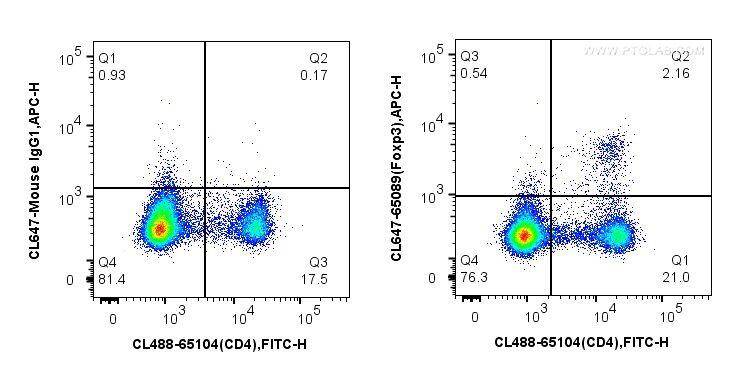- Featured Product
- KD/KO Validated
CoraLite®647-conjugated P16-INK4A Polyclonal antibody
P16-INK4A Polyclonal Antibody for FC (Intra)
Host / Isotype
Rabbit / IgG
Reactivity
human
Applications
FC (Intra)
Conjugate
CoraLite® Plus 647 Fluorescent Dye
Cat no : CL650-10883
Synonyms
Validation Data Gallery
Tested Applications
Recommended dilution
| Application | Dilution |
|---|---|
| Sample-dependent, check data in validation data gallery | |
Product Information
CL650-10883 targets P16-INK4A in FC (Intra) applications and shows reactivity with human samples.
| Tested Reactivity | human |
| Host / Isotype | Rabbit / IgG |
| Class | Polyclonal |
| Type | Antibody |
| Immunogen | P16-INK4A fusion protein Ag1328 相同性解析による交差性が予測される生物種 |
| Full Name | cyclin-dependent kinase inhibitor 2A (melanoma, p16, inhibits CDK4) |
| Calculated molecular weight | 16 kDa |
| Observed molecular weight | 16-18 kDa |
| GenBank accession number | BC021998 |
| Gene symbol | CDKN2A |
| Gene ID (NCBI) | 1029 |
| RRID | AB_2920359 |
| Conjugate | CoraLite® Plus 647 Fluorescent Dye |
| Excitation/Emission maxima wavelengths | 654 nm / 674 nm |
| Form | Liquid |
| Purification Method | Antigen affinity purification |
| Storage Buffer | PBS with 50% Glycerol, 0.05% Proclin300, 0.5% BSA, pH 7.3. |
| Storage Conditions | Store at -20°C. Avoid exposure to light. Aliquoting is unnecessary for -20oC storage. |
Background Information
Background
p16 is an important cell cycle regulator and acts as a tumor suppressor. It may also be referred to as one of a number of synonyms, including p16INK4a and cyclin-dependent kinase inhibitor 2A.
What is the molecular weight of P16?
16kDa. P16 is encoded by the CDKN2A gene in humans and is a chain comprising 148 amino acids.
What is the function of p16?
P16 inhibits cells from progressing from G1 into S phase, binding to cyclin-dependent kinase 4 (CDK4) and inhibiting its kinase ability, so that it cannot phosphorylate the retinoblastoma tumor suppressor (RB). Without this phosphorylation, RB does not activate downstream genes, so the G1/S checkpoint cannot be passed and the cell does not proliferate (PMID: 8259215).
What is the role of p16 in senescence?
In senescence, cells are irreversibly arrested in the cell cycle. P16 is expressed more highly in aging tissue, is associated with intrinsic cellular aging signals such as telomere shortening, and can therefore be used as a marker of senescence (PMID: 9244355; PMID: 19535234). Due to its role in cell cycle arrest, p16 drives the initiation and maintenance of a cellular senescent phenotype.
What is the role of p16 in cancer?
As a negative regulator of proliferation, p16 is a known tumor suppressor. Mutations in the CDKN2A gene that lead to inactivation of p16 protein have been associated with an increased risk of cancer and are often observed in primary tumors and in cancer cell lines (PMID: 9508208). The inactivation of p16 has been shown to be a key early stage of tumor progression. In a small number of tumor types that are caused by the human papilloma virus (HPV), p16 is in fact overexpressed when RB is inactivated, releasing p16 and causing an accumulation (PMID: 21297668).
Protocols
| Product Specific Protocols | |
|---|---|
| FC protocol for CL Plus 647 P16-INK4A antibody CL650-10883 | Download protocol |
| Standard Protocols | |
|---|---|
| Click here to view our Standard Protocols |


